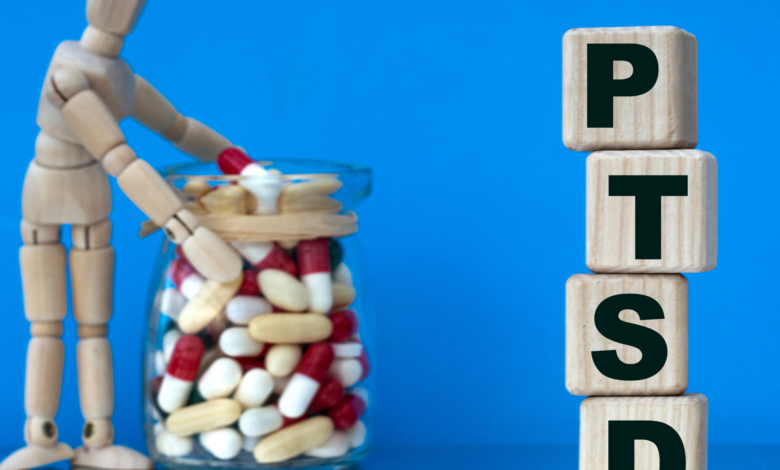Understanding PTSD: What Is It and Its Impact

Have you ever wondered what happens to someone’s mind after a traumatic event? How it affects their daily life, their relationships, and their overall well-being? Post-traumatic stress disorder (PTSD) is a complex mental health condition that can have a profound impact on individuals who have experienced or witnessed a traumatic event. But what exactly is PTSD? What are its symptoms, causes, and available treatments?
In this article, we will explore the world of PTSD, unraveling its mystery and shedding light on its effects. From understanding the definition of PTSD to delving into its symptoms, causes, and the impact it has on veterans, we will take a closer look at this condition and provide valuable insights into its treatment options and the importance of trauma-informed care.
Key Takeaways:
- PTSD is a mental health condition that develops after experiencing or witnessing a traumatic event.
- Symptoms of PTSD can include flashbacks, nightmares, severe anxiety, and changes in mood and behavior.
- PTSD can be caused by a variety of traumatic events, including combat exposure and physical or sexual assault.
- Veterans are particularly vulnerable to PTSD due to their exposure to highly traumatic events during military service.
- Treatment options for PTSD include psychotherapy, medication, and trauma-focused therapies.
What Is PTSD?
PTSD, or post-traumatic stress disorder, is a psychiatric disorder that can develop in individuals who have experienced or witnessed a traumatic event. This event can be an actual or perceived threat to one’s life or safety. It is a complex condition that can have long-lasting effects on a person’s mental and emotional well-being. PTSD is characterized by a range of symptoms that can persist long after the traumatic event has occurred.
When defining PTSD, it is important to understand that it is not a sign of weakness or a character flaw. It is a legitimate psychiatric condition that requires proper recognition and treatment. PTSD can affect anyone, regardless of age, gender, or background. It commonly occurs in individuals who have experienced traumatic events such as natural disasters, combat exposure, physical or sexual assault, accidents, or any event that causes intense fear, helplessness, or horror.
The symptoms of PTSD can be diverse and vary from person to person. Common symptoms include intrusive memories, flashbacks, nightmares, severe anxiety, avoidance of trauma-related triggers, negative changes in thinking and mood, and changes in physical and emotional reactions. These symptoms can significantly impair daily functioning, relationships, and overall quality of life.
“PTSD is a psychiatric disorder that can occur in individuals who have experienced or witnessed a traumatic event.”
Seeking help for PTSD is crucial for individuals to begin their journey towards healing and recovery. Effective treatment options are available, including therapy, medication, support groups, and holistic approaches. By understanding and acknowledging the definition and impact of PTSD, we can provide support and resources to those affected, helping them regain control over their lives.
Symptoms of PTSD
The symptoms of post-traumatic stress disorder (PTSD) can manifest differently in each individual, but they generally fall into four categories:
- Intrusive memories: This category includes recurring, distressing thoughts or memories of the traumatic event, flashbacks, and nightmares. These intrusive memories can be overwhelming and make it difficult for individuals to focus on daily tasks or sleep peacefully.
- Avoidance: Individuals with PTSD often try to avoid any reminders of the trauma, including places, activities, or people associated with the event. Avoidance symptoms can lead to social isolation and a limited participation in daily life.
- Negative changes in thinking and mood: PTSD can cause significant negative changes in an individual’s thinking and mood. This may include negative thoughts about oneself or the world, feelings of detachment or numbness, and a loss of interest in activities that were once enjoyable.
- Changes in physical and emotional reactions: People with PTSD may exhibit changes in their physical and emotional reactions. These can include being easily startled, having difficulty sleeping or concentrating, feeling constantly on edge, experiencing irritability or anger, and engaging in self-destructive behaviors as a coping mechanism.
It is important to note that these symptoms must persist for at least one month and significantly interfere with daily functioning in order to be diagnosed as PTSD. If you or someone you know is experiencing these symptoms, it is crucial to seek professional help and support to effectively manage and treat PTSD.
Causes of PTSD
PTSD, or post-traumatic stress disorder, can develop as a result of various traumatic events. These events can range from single incidents, such as car accidents or natural disasters, to ongoing experiences like childhood abuse or military combat. The causes of PTSD are multifactorial, influenced by the severity and duration of the trauma, an individual’s personal characteristics and coping skills, and their support system.
One of the significant factors that contribute to the development of PTSD is the intensity of the traumatic event. Events that involve significant physical or emotional harm, such as physical assault or witnessing a life-threatening situation, are more likely to trigger the disorder. The duration of the trauma can also play a role, as prolonged exposure to distressing circumstances can increase the risk of developing PTSD.
Personal characteristics and coping skills also influence the development of PTSD. Individuals who have preexisting mental health conditions, such as anxiety or depression, may be more susceptible to developing PTSD after a traumatic event. Additionally, individuals with limited coping mechanisms or poor social support networks may be at a higher risk.
Genetic and neurobiological factors may also contribute to an individual’s vulnerability to PTSD. Research suggests that certain genetic variations may affect how an individual responds to trauma and processes stress. Neurobiological changes in the brain, particularly in areas related to fear and stress regulation, can influence an individual’s reaction to traumatic events.
The Role of Support System
A strong support system can play a crucial role in mitigating the impact of trauma and reducing the risk of developing PTSD. Having supportive friends, family, or professionals to lean on can provide a sense of safety, comfort, and validation. Supportive relationships can promote resilience and help individuals process their traumatic experiences in a healthy manner.
“The support I received from my loved ones and therapy sessions helped me navigate through my trauma and build a new life.” – Jane Doe, PTSD survivor
It is important to note that not everyone exposed to traumatic events will develop PTSD. The development of the disorder depends on various factors and is a highly individualized experience. Understanding the causes of PTSD can aid in identifying at-risk individuals, implementing preventive measures, and providing appropriate support and treatment.
| Causes of PTSD | Description |
|---|---|
| Single Incidents | Car accidents, natural disasters, physical assault |
| Ongoing Experiences | Childhood abuse, military combat, domestic violence |
| Severity and Duration | Intensity and prolonged exposure to trauma |
| Personal Characteristics | Preexisting mental health conditions, coping skills |
| Support System | Availability of social support networks |
| Genetic and Neurobiological Factors | Genetic variations and neurobiological changes |
The Impact of PTSD on Veterans
PTSD is commonly associated with military veterans, as they may have been exposed to highly traumatic events during their service. The effects of PTSD on veterans can be far-reaching, impacting their mental health, relationships, and overall quality of life.
Veterans with PTSD often face difficulties in readjusting to civilian life. The traumatic experiences they have encountered during their service can make it challenging to reintegrate into society. The memories and emotions associated with their trauma can cause significant distress and hinder their ability to engage in normal daily activities.
Moreover, veterans with PTSD may be more prone to substance abuse as a way to cope with their symptoms. The pain, anxiety, and sleep disturbances caused by PTSD may drive some veterans to misuse drugs or alcohol in an attempt to find relief from their distressing experiences.
In addition, maintaining stable employment and housing can become major challenges for veterans with PTSD. The symptoms of PTSD, such as hypervigilance, irritability, and difficulty concentrating, can interfere with their ability to perform job responsibilities efficiently. This can lead to unemployment or frequent job changes. Similarly, the emotional and financial strains associated with PTSD can contribute to instability in housing situations, making it difficult for veterans to find long-term stability.
To mitigate the impact of PTSD on veterans, it is crucial to provide them with appropriate support and resources. This includes access to quality mental healthcare, specialized treatment programs, and community resources. Additionally, raising awareness and reducing the stigma surrounding PTSD can encourage veterans to seek help and improve their overall well-being.
“PTSD is a significant burden for many veterans, and it requires a comprehensive support system to help them overcome its challenges and regain their lives.”
By prioritizing the mental health and well-being of veterans and ensuring they have access to the care they need, we can make meaningful strides in alleviating the impact of PTSD on this deserving population.
Treatment Options for PTSD
Individuals with PTSD have a variety of treatment options available to manage their symptoms and improve their quality of life. These options are tailored to address the unique needs of each individual and can encompass a combination of psychotherapy, medications, support groups, self-help strategies, and holistic approaches.
Trauma-Focused Therapy
Trauma-focused therapy, a form of psychotherapy, is a common approach in treating PTSD. It involves specific techniques designed to address the traumatic experiences and associated symptoms. Cognitive-behavioral therapy (CBT), for example, helps individuals identify and change negative thought patterns, leading to healthier behaviors and emotions. Eye movement desensitization and reprocessing (EMDR) focuses on using bilateral stimulation to process traumatic memories and reduce distress. Exposure therapy gradually exposes individuals to feared situations or memories, helping them feel more in control and less anxious.
Medications
In certain cases, healthcare professionals may prescribe medications to help alleviate the symptoms of PTSD. Selective serotonin reuptake inhibitors (SSRIs), such as sertraline and paroxetine, are commonly prescribed to reduce anxiety, depression, and intrusive thoughts. These medications work by increasing the levels of serotonin in the brain, promoting a sense of calm and stability.
Support Groups and Self-Help Strategies
Support groups provide a safe and empathetic environment for individuals with PTSD to share their experiences, learn from others, and gain emotional support. These groups can be facilitated by mental health professionals or peers who have experienced similar challenges. Additionally, self-help strategies, such as journaling, practicing relaxation techniques, and engaging in physical activities, empower individuals to develop coping mechanisms and regain a sense of control over their lives.
Holistic Approaches
In addition to traditional therapy and medications, holistic approaches can complement PTSD treatment. Mindfulness-based techniques, such as meditation and deep breathing exercises, promote stress reduction and help individuals stay present in the moment. Relaxation techniques, such as yoga or progressive muscle relaxation, can relieve anxiety and promote overall well-being. These approaches focus on the mind-body connection and can enhance the healing process.
Remember, treatment for PTSD may vary for each individual. It is essential to consult with a qualified healthcare professional to develop a personalized treatment plan based on your specific needs and circumstances.
| Treatment Options | Benefits |
|---|---|
| Trauma-Focused Therapy | Addresses traumatic experiences and associated symptoms |
| Medications | Reduces anxiety, depression, and intrusive thoughts |
| Support Groups and Self-Help Strategies | Provides emotional support and empowers individuals with coping mechanisms |
| Holistic Approaches | Promotes stress reduction and enhances the mind-body connection |
Understanding Trauma-Informed Care
Trauma-informed care is an essential approach to healthcare that aims to provide compassionate support and treatment to individuals who have experienced trauma, such as PTSD. This approach acknowledges that trauma can have a widespread impact on a person’s physical, emotional, and psychological well-being and seeks to create an environment that promotes safety, trust, and empowerment.
In trauma-informed care, healthcare providers recognize the potential triggers and sensitivities associated with trauma and make efforts to avoid re-traumatization. This means taking into account the unique needs and experiences of individuals with PTSD and providing care that is sensitive, nonjudgmental, and responsive to their specific concerns and challenges.
A core principle of trauma-informed care is the understanding that individuals who have experienced trauma may have different coping mechanisms and responses to stress. By acknowledging and respecting these differences, healthcare providers can foster a supportive environment that facilitates healing and recovery.
“Trauma-informed care acknowledges the widespread impact of trauma and strives to create an environment that promotes safety, trust, and empowerment for individuals with PTSD.”
Key elements of trauma-informed care include:
- Creating physical and emotional safety: Healthcare settings should be designed to minimize potential triggers and provide a sense of safety and security for individuals with PTSD.
- Building trust and transparency: Healthcare providers should prioritize honest communication, active listening, and respect for the individual’s autonomy and choices.
- Cultivating a collaborative approach: Individuals with PTSD should be actively involved in their care and treatment decisions, allowing them to feel empowered and in control of their recovery.
- Recognizing the impact of trauma on health and well-being: Healthcare providers should assess and address the various physical, emotional, and psychological effects of trauma, tailoring treatment plans accordingly.
Trauma-informed care is an inclusive and holistic approach that acknowledges the complexity and varied experiences of individuals with PTSD. By integrating this approach into healthcare settings, we can create an environment that promotes healing, resilience, and positive outcomes for individuals affected by trauma.
Common Reactions and Responses to Trauma
Trauma can elicit a wide range of reactions and responses from individuals. When confronted with a traumatic event, immediate reactions can include confusion, sadness, anxiety, and physical arousal. These responses reflect the intense emotions and physiological changes that trauma triggers in the body and mind. It is important to acknowledge and validate these initial reactions, as they are normal and an inherent part of the trauma response.
However, trauma can also lead to delayed responses that persist over time. One common delayed response to trauma is persistent fatigue, which can result from the emotional and physical exhaustion that accompanies the healing process. Sleep disorders, such as insomnia or nightmares, are also prevalent among individuals affected by trauma, as their sleep patterns can be disrupted by intrusive thoughts and distressing memories.
Another common response to trauma is the avoidance of trauma-related emotions or activities. Those who have experienced trauma may inadvertently develop avoidance behaviors or take deliberate steps to steer clear of reminders that trigger painful memories. This avoidance is a protective mechanism aimed at minimizing distress and regaining a sense of control.
The impact of trauma can vary significantly based on individual factors, such as prior experiences, coping mechanisms, and resilience. The specific characteristics of the traumatic event, such as its severity and duration, also influence the responses and reactions observed. Additionally, sociocultural influences play a role in shaping individuals’ responses to trauma, as cultural norms and societal expectations can impact the expression and interpretation of trauma-related emotions.
Recognizing and understanding these common reactions and responses is vital when providing support to individuals affected by trauma. It enables empathetic and responsive care that acknowledges the complexity and uniqueness of each person’s experience. By fostering a safe and validating environment, we can help individuals navigate the path to healing and recovery.
The Impact of Trauma Responses
The impact of trauma responses can be significant, affecting multiple aspects of an individual’s life. These responses can interfere with daily functioning, impair relationships, and hinder overall well-being. Individuals may experience difficulties in work, school, or personal relationships due to emotional and cognitive challenges associated with trauma. It is crucial to provide a supportive environment that promotes understanding and facilitates access to appropriate resources and professional help. By addressing trauma responses, we can empower individuals on their journey of healing and resilience.
The Role of Culture in PTSD
Culture plays a significant role in defining and understanding mental illness, including PTSD. Cultural factors can influence the perception and expression of trauma and associated symptoms. Beliefs, values, and cultural practices can shape an individual’s conceptualization of trauma and influence their help-seeking behaviors.
Cultural competency and sensitivity are essential when providing support and treatment to individuals from diverse cultural backgrounds who are affected by PTSD.
Understanding the cultural factors that impact PTSD can help healthcare professionals deliver appropriate care and support to patients. It is important to recognize that different cultures may have distinct ways of understanding and coping with trauma.
“Cultural competency involves being aware of and respectful towards the cultural beliefs, traditions, and values of individuals. By incorporating cultural perspectives into treatment approaches, mental health professionals can promote better outcomes for individuals with PTSD.”
Examples of Cultural Factors in PTSD:
- Cultural stigmas around mental illness may prevent individuals from seeking help or disclosing their symptoms.
- Traditional healing practices and ceremonies may play a significant role in the recovery process.
- Collectivist cultures may prioritize community support and connection as important resources for healing.
- Gender roles and expectations may influence how symptoms of PTSD are expressed and perceived.
- Cultural taboos may influence the reporting or disclosure of traumatic experiences.
By taking a culturally sensitive approach to PTSD, healthcare professionals can effectively address the unique needs of individuals from different cultural backgrounds and provide the appropriate support and treatment they require.
Cross-Cultural Perspectives on PTSD
| Cultural Factor | Impact on PTSD |
|————————-|——————————————-|
| Cultural stigma | May discourage help-seeking behavior |
| Traditional practices | Can influence the recovery process |
| Collectivist cultures | Emphasize community support for healing |
| Gender roles | Influence expression and perception of symptoms |
| Cultural taboos | May affect reporting and disclosure of trauma |
(This table provides an overview of how different cultural factors can impact the understanding and management of PTSD within various communities.)
Living with PTSD: Coping and Support
Living with post-traumatic stress disorder (PTSD) can be incredibly challenging, but it is possible to lead a fulfilling life with the right coping strategies and support. If you or someone you know is affected by PTSD, it’s crucial to understand the importance of self-care, professional help, and a strong support network.
Engaging in self-care activities: Taking care of oneself is vital for managing the symptoms of PTSD. Engaging in activities that promote relaxation, such as exercise, meditation, and creative outlets, can help reduce stress levels and improve overall well-being. Nurturing physical health through proper nutrition, regular sleep patterns, and avoiding substance abuse is also important. By making self-care a priority, individuals can create a solid foundation for healing.
Practicing relaxation techniques: Techniques like deep breathing exercises, progressive muscle relaxation, and guided imagery can help individuals manage anxiety and promote a sense of calm. These techniques are valuable tools in reducing the intensity of PTSD symptoms and improving daily functioning.
Maintaining a strong support network: Connecting with loved ones, friends, and support groups can be immensely helpful for individuals with PTSD. Surrounding oneself with understanding and compassionate people can provide emotional support, validation, and a safe space to share experiences. By building a network of reliable individuals who offer empathy and encouragement, individuals with PTSD can feel less isolated.
Seeking professional help when necessary: Mental health professionals, such as therapists and counselors, can provide specialized support and evidence-based treatments for PTSD. Therapy options like cognitive-behavioral therapy (CBT), eye movement desensitization and reprocessing (EMDR), and exposure therapy have been proven effective in addressing PTSD symptoms. Seeking professional help allows individuals to gain essential insights, learn coping strategies, and develop resilience while working through the challenges of PTSD.
Conclusion
PTSD is a complex mental health condition that can have a profound impact on individuals’ lives. Understanding the causes, symptoms, and available treatments for PTSD is essential in providing support and resources to those affected. By fostering empathy, promoting trauma-informed care, and offering effective treatments, we can help individuals with PTSD navigate their recovery journey and regain a sense of control and well-being.
Empathy is crucial in supporting individuals with PTSD. By validating their experiences and emotions, we can create a safe space for them to share and heal. Providing trauma-informed care, which recognizes the impact of trauma and prioritizes safety and empowerment, is essential for assisting individuals with PTSD on their path to recovery.
Offering a range of evidence-based treatments is key in addressing the symptoms of PTSD. Psychotherapy, such as trauma-focused therapy, can help individuals process their traumatic experiences and develop coping strategies. Medications, support groups, and self-help strategies can also play important roles in managing symptoms and improving overall well-being.
In conclusion, by increasing awareness of PTSD, destigmatizing mental health, and ensuring accessible and effective treatments, we can make a significant difference in the lives of individuals impacted by this condition. With the right support, individuals with PTSD can regain control, find healing, and rebuild their lives.







